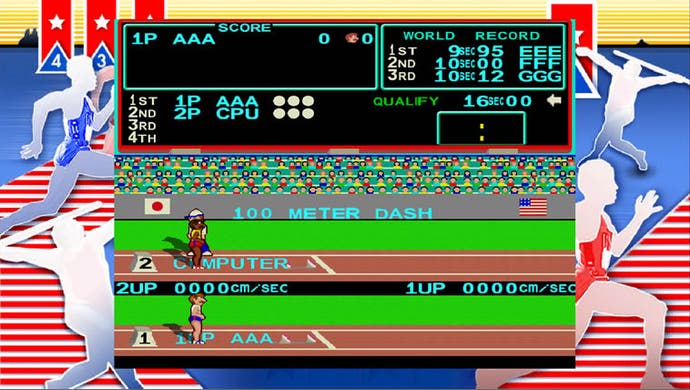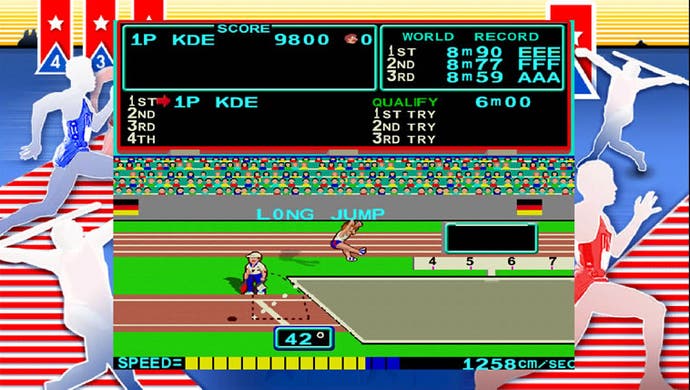Track & Field
Let the RSI epidemic commence!
Now and then, a classic pops up on Xbox Live Arcade that's every bit as life-affirmingly brilliant as it was when it very first came out. Track & Field (or Hyper Olympics as it was known outside of the US) is one of those games, and we couldn't be happier to have it back in our lives again. It was the first, and, somehow, 24 years on, it's still one of the very best. Even Konami itself has had trouble topping it.
The premise is about as simple as arcade gaming gets. You (and up to three other players) take part in a series of button-mashing athletic events with the idea to qualify for the next one and get a better result than your opponent(s). If you fail to qualify, it's Game Over. If you succeed, it's on to the next one until you eventually get knocked out.
Much imitated, rarely bettered
To begin with, the 100-metre sprint keeps things simple - if you can avoid a false start. The faster you alternately mash two buttons (or left and right on the joystick or d-pad - it's up to you) the faster you run. The faster you run, the more chance you have of winning. It sounds straightforward, but firing your digits at extraordinary velocity is akin to triggering a self-imposed epileptic fit. It takes a special kind of gamer to warm to the task. Most of us just collapse in a broken heap, almost as exhausted as we would be in real life. If you've somehow avoided playing one of these games before, be warned - it's one of the most bizarrely amusing spectacles gaming has ever given us.
The Long Jump, meanwhile, is no less frenzied - but requires a fair bit more skill. Not only are you tasked with mashing the buttons as fast as you can, but you must time the moment of your jump and its subsequent angle by pressing and holding the 'set' button for a split second as you approach the line. Time it just right and you'll get somewhere near the desired 45-degree angle. Do it on the line, and you'll get an extra speed boost as you soar in slow motion to the end of the pit. Jump at a crazy angle, too early, or over the line, and things won't go quite so well.

Elsewhere, the Javelin Throw repeats the Long Jump 'run, set, angle' formula almost exactly, while the 110m Hurdles require alternately sprinting and timing jumps. Frantic stuff. It calms down a notch with the Hammer Throw, with no requirement to mash the buttons at all. Respite. Viewed from above, you see your moustachioed hero (think the 118 ads) swinging his hammer in a sequence of rotations. The later you time your throw, the faster and further you will hurl the hammer - but the harder it becomes to time it. And finally, the rather evil High Jump also dispenses with button-mashing, with the requirement this time on timing - not only in terms of where you start your leap from, but when to tweak the angle of your descent.
Foul!
If you can squeak past the curious demands of the High Jump qualification requirements, you keep going until you've failed three times. After that, a cheesy podium sequence, and then the whole thing loops around, but with more extreme qualifying targets. The whole thing's over and done with very quickly, but that's all part of the game's almost irresistible 'one more go' appeal - an allure made all the more impossible to ignore in the knowledge that every single event has its own worldwide leaderboard. Proving to your mates that you're a hyper autoepileptic jerk-off is surely what it's all about? No?
Onto serious port-related matter, Track & Field gets the usual Digital Eclipse/Konami can't-be-arsed makeover. That's to say it's nothing to get excited about but, for once, it rather suits the style of the 1983-era visuals. Turning off the enhanced graphics and sound isn't really advisable, unless you're really desperate to make it look pixellated and ugly. Widescreen has, yet again, been overlooked in favour of a basic graphical surround (similar to how we recall the arcade cab, with its red and white stripes adorning the edges).

But what makes this port interesting isn't so much the buffed-up graphics and sound, but the ability to play the game online with up to three other players. Although lag can be a bit of an issue if you wind up with the wrong players, when it's working as it should, the game is an absolute blast. Simultaneous two-player events like the 100m Sprint and 110m Hurdles are as frantic as online gaming gets for those 10 or so seconds your punishing the pad. Even the take-it-in-turns events work brilliantly too, trying desperately to outdo one another.
Lock up your pads
As for how the game works on the pad - the answer is surprisingly well. We tended to go for the 'turn-the-pad-on-its side' approach, waggling the left stick furiously, and using the A button where necessary. Trying to use the buttons or d-pad to build up speed proved fairly fruitless, though. But if you really want to be able to post ninja times, it's more than likely you'll need one of those DoA arcade joysticks with big fat buttons or a joystick you can waggle like an utter psycho.
So that's Track & Field - untainted by the passing of time, and still as mindlessly entertaining as it was back in the day. Sure, Hyper Sports improved on the formula a little, and Epyx went off and took the idea to dizzy heights not long after that, but in essence this is one of those few occasions when a game concept emerged fully formed from the beginning. For 400 measly points you can't really go wrong with what is undoubtedly one of the finest retro additions to Live Arcade to date.








